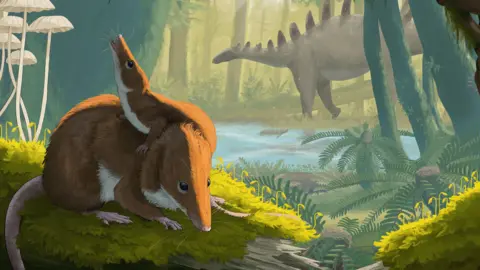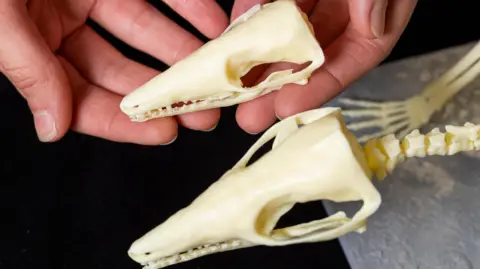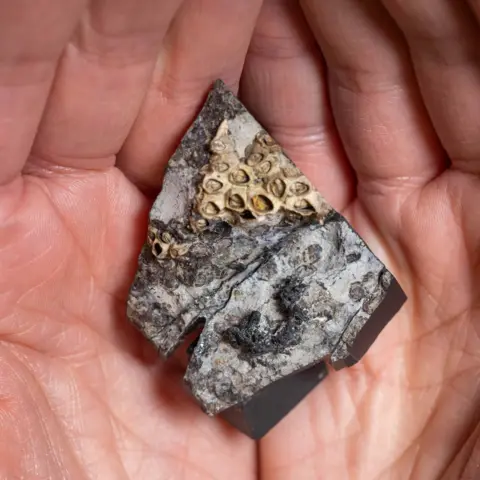
 Maija Karala
Maija Karala
The small furry Jurassic mammal scampered at the feet of dinosaurs (artist impression)
Two incredibly rare fossils found on Scotland's Isle of Skye are rewriting our understanding of how mammals evolved.
While modern small mammals live as little as a year, one of the first to roam the earth, alongside dinosaurs, could reach seven years and beyond, scientists have discovered.
Only a handful of fossils of the primitive shrew-like mammal, Krusatodon, have ever been found, including two exceptionally complete skeletons of a juvenile and an adult from Skye.
By studying fossils of the earliest mammals, scientists hope to unlock the secrets of how they rose to become super successful animals occupying every habitat on the planet.

 Duncan Mc Glynn
Duncan Mc Glynn
Enlarged, 3D printed models of the animals' skeletons
The researchers used hi-tech X-ray imaging to peer through rock and study growth patterns in the teeth of the two fossils, much like counting tree rings.
“The juvenile was weaning – replacing its teeth – and yet it was as much as two years of age, Dr Elsa Panciroli, Associate Researcher of Palaeobiology at National Museums Scotland told BBC News. "This is unusual and tells us a lot about how mammals' evolution took place.”
Small mammals living today have much shorter lifespans, some surviving for as little as 12 months, and maturing quickly, losing their baby teeth and weaning within months of birth.

 Duncan Mc Glynn
Duncan Mc Glynn
The delicate bones of the Skye fossils are still encased in rock
The creature, Krusatodon kirtlingtonesis, lived around 166 million years ago when Skye was a sub-tropical paradise with warm shallow seas and dense forests.
In this Jurassic period, the first mammals were gaining a foothold in the shadow of the dinosaurs.
Tiny, primitive and sometimes quite strange, they were the precursors of the thousands of different mammals living today, from cats to humans to whales.
Fossil treasure trove
Dr Panciroli said Skye’s fossils are putting Scotland firmly on the map when it comes to understanding mammal evolution and "this is just the tip of the iceberg in terms of what they can tell us".
The Krusatodon fossil discovered on Skye in 2016 is the only juvenile Jurassic mammal skeleton known to science, while the adult, found in the 1970s, is one of the most intact mammal skeletons from this time period in the world.
“To find two such rare fossil skeletons of the same species at different growth stages has rewritten our understanding of the lives of the very earliest mammals,” said Dr Stig Walsh, Senior Curator of Vertebrate Palaeobiology at National Museums Scotland and co-researcher on the study.
The study, published in Nature, also involved researchers from the American Museum of Natural History, University of Chicago, European Synchrotron Radiation Facility, and Queen Mary University of London.

 Movie
Movie 3 months ago
74
3 months ago
74 






![Presidents Day Weekend Car Sales [2021 Edition] Presidents Day Weekend Car Sales [2021 Edition]](https://www.findthebestcarprice.com/wp-content/uploads/Presidents-Day-Weekend-car-sales.jpg)



 English (United States)
English (United States)